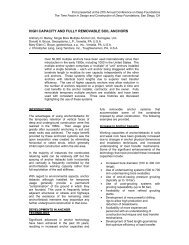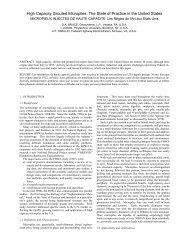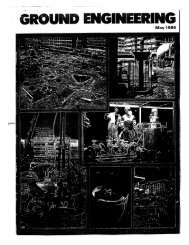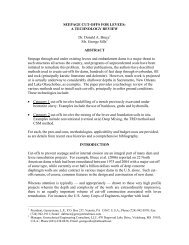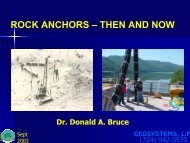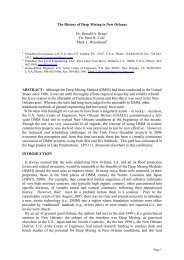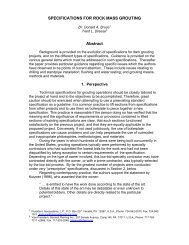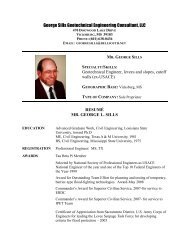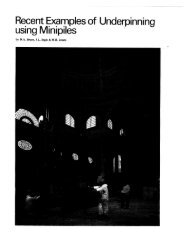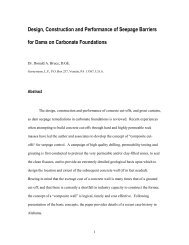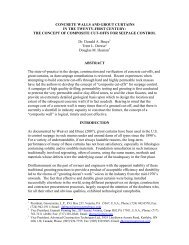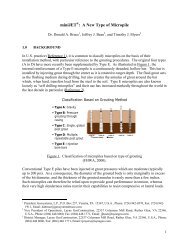1 Dam Remediation by Anchors and Cut-Offs: A ... - Geosystems, LP
1 Dam Remediation by Anchors and Cut-Offs: A ... - Geosystems, LP
1 Dam Remediation by Anchors and Cut-Offs: A ... - Geosystems, LP
Create successful ePaper yourself
Turn your PDF publications into a flip-book with our unique Google optimized e-Paper software.
2.2.2 Detailed Comparison <strong>by</strong> Technical Topic<br />
The structure of each successive edition has changed in the same way that the content<br />
has, although there are comparatively few structural differences between the 1996 <strong>and</strong><br />
2004 versions. The following comparison therefore is based on the structure of the<br />
2004 version.<br />
Scope <strong>and</strong> Definitions (Chapters 1 <strong>and</strong> 2)<br />
The scope has remained relatively constant, <strong>and</strong> focuses on the anchors themselves<br />
(as components) as opposed to the analysis <strong>and</strong> design of the overall anchored system.<br />
A total of 72 technical terms are now defined, which represents a major expansion<br />
even over the 1996 edition: the first edition had 24 definitions, most of which,<br />
incidentally, remain valid <strong>and</strong> little changed.<br />
Specifications, Responsibilities <strong>and</strong> Submittals (Chapter 3)<br />
Whereas 1974 provided no insight into specifications <strong>and</strong> responsibilities, certain<br />
records were required to be maintained on the grouting operations. By 1980,<br />
however, specifications had been addressed, reflecting the need to tailor procurement<br />
processes to “experienced” contractors, “thoroughly experienced” <strong>and</strong> match the<br />
innovation of the technique with alternative procurements methods. It is notable that<br />
the three types of specification outlined in 1980 (namely open, performance <strong>and</strong><br />
closed) have endured, although “closed” is now referred to as “prescriptive.”<br />
Building on a 1996 innovation, the responsibilities to be discharged during a project<br />
— regardless of type of specification — were summarized in 2004 as shown in<br />
Table 2. Clear guidance is also provided on the content of preconstruction submittals<br />
<strong>and</strong> as-built records. The former also include the requirement for the contractor to<br />
prepare a Construction Quality Plan. Emphasis remains on the need for “specialized<br />
equipment, knowledge, techniques <strong>and</strong> expert workmanship” <strong>and</strong> for “thoroughly<br />
experienced” contractors. The obvious, but often ignored, benefit of “clear<br />
communication <strong>and</strong> close co-operation,” especially in the start up phase of a project,<br />
is underlined.<br />
Anchor Materials (Chapter 4)<br />
The 1974 document very briefly refers to wires, str<strong>and</strong>, <strong>and</strong> bars, <strong>and</strong> to protective<br />
sheathing. In stark contrast, the current version has built to 10 pages providing<br />
definitive detail on materials used in each of the 10 major anchor components, with<br />
particular emphasis placed on steel, corrosion-inhibiting compounds, sheathings <strong>and</strong><br />
grouts (cementitious <strong>and</strong> polyester). Strong cross-reference to relevant ASTM<br />
st<strong>and</strong>ards is provided as a direct guide to specification drafters.<br />
4



